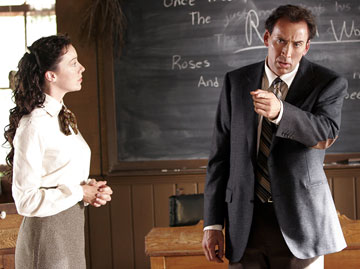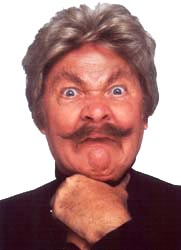Welcome to our annual Thanksgiving turkey strangle - ten films that give bad a new name.Here are last year's Turkeys part one and part two. Every year we pick some of cinemas low flyers for special shame and ridicule. To the list!

1) The Wicker Man(remake)
The remake of a well regarded film is not an uncommon species of turkey, in fact this list sports several. However It must be said that the dropoff from the creepy Edward “The Equalizer” Woodward starring original to this Neil LaBute helmed crapfest is mighty steep. Aside from the nonsensical plot the main attraction for J.G. Ballard-esque car wreck fans is Nicholas Cage’s performance, a masterclass in frantic, pointless scenery chewing that reads like a bad Nic Cage impersonator “doing” Nic Cage. LaBute naturally focuses his attention on the evil women who run the mysterious island where cop Cage has gone to look for his ex-paramour’s missing child. Never has gynophobia seemed so downright silly.You'll root for the murderers.

2) Under the Rainbow
It’s hard to know what anyone involved in this awful film were thinking. Set in 1938 it involves 150 midgets in town to film the Wizard of Oz, Chevy Chase as a secret service agent, Carrie Fisher as the midget’s chaperon and a lot of convoluted plotting involving Nazis and fake European countries. Like A Fish Called Wanda, the cardinal Hollywood rule of avoiding dog deaths is overlooked. Unlike Wanda, it’s simply not funny here.

3) The Jerk, Too
Some of you might remember ABC’s short-lived Saturday Night Live knockoff Fridays, which in the early 80s introduced a small audience to Michael Richards and Larry David. One of the breakout stars was Mark Blankfield, whose over-the-top pharmacist character propelled him to this ill-considered remake of Steve Martin’s 1979 classic The Jerk, barely 5 years after the original.

4) Employee of the Month
My wife and I valiantly attempted to watch this excrescence on cable, just to see at what point one of us would cry chicken and call the whole thing off. What we didn’t bargain for is becoming literally mind-boggled by a seemingly interminable scene talking place high up in the stacks of the giant warehouse store where Dane Cook and his co-workers, well, work. The plot involves some meaningless bullcrap about Jessica Simpson and Cook – two “actors” notably devoid of charm here, and some desire by Cook to date Simpson who only dates employees of the month so Cook has to…snnnnnOOORRK!When my wife and I came to, we felt like Betty and Barney Hill - the couple who knew they were kidnapped by aliens because they had experienced chunks of missing time from their lives.

5) Stepford Wives (remake)
The original Stepford Wives was no great film, just a campy sub-Rosemary’s Baby vamp on The Feminine Mystique. Frank Oz’s ill-considered re-make is a mess, overstuffed, over-budgeted and over-plotted. Bad remake queen Nicole Kidman (of future turkey entries Invasion and Bewitched) does her accent from To Die For and generally fails to look like the kind of woman a man would want to upgrade with a robot/lobotomy or whatever it is they are supposed to be. Bette Midler does her loud earthy shtick and Christopher Walken does his creepy weird-line-delivery shtick. Oh yeah, and Matthew Broderick throws down his super nebbish routine. Did I mention that the movie doesn’t even know if the housewives are being lobotomized, or turned into robots, or what? The one surefire lobotomy victim is the viewer after watching this dreck.

6) The Nude Bomb
Before Steve Carrell was tapped to do a remake of the classic Mel Brooks and Buck Henry created spy spoof TV show Get Smart, the show itself was turned into a movie in 1980 – the aptly named Nude Bomb. Only Don Adams, the original and best Maxwell Smart, returns from the TV cast. Sylvia Kristol better known as soft-core star Emmanuelle is the love interest (!). Vittorio Gassman gets roped in, presumable to pay the electric bill. Deserves the cone of silence.

7) Moving Violations
Police Academy mastermind Neal Isreal transported his already Xeroxed transposition of Animal House antics to traffic school in this comedy tribute to nepotism. Lesser-known Murray sibling John Murray is not asked to imitate brother Brian Doyle in this film but other brother Bill, to slim returns. He’s up against Stacy Keach’s brother James Keach who is tofurky to Stacy’s Thanksgiving meal. These two sibs are balanced out by Jennifer Tilly, who had not yet eclipsed sister Meg. Also, Don Cheadle shows up ever so briefly. It’s entirely a movie by association, if you liked Police Academy, Ghostbusters, and Mike Hammer, you’ll hate Moving Violations.

8) Heartbeeps
Andy Kaufman and Bernadette Peters star as robot domestics who escape and fall in robot love. Vincent Canby’s original review notes that “The makeup worn by Mr. Kaufman and Miss Peters looks formidably uncomfortable.” So do the actors and everyone remotely associated with this mess.Walks the fine line between boring and subtly disturbing.

9) Memoirs of an Invisible Man
Two of the most inexpressive actors in cinema, Chevy Chase and Daryl Hannah team up in what sadly is an action adventure. Even Chase’s vocal inflections in the invisible scenes are blah and poor John Carpenter is reduced to wishing Kurt Russell had been available in this listless special effects extravaganza. Sam Neill’s mole has more range than the leads and Carpenter seems to try to get him on camera as much as possible to no avail. Note how the trailer attempts to sell the film as a comedy and then undercuts the whole thing with " A John Carpenter Film"...

10) Zardoz
Ladies love Sean Connery but one look at his over-exposed furry body in the weird bondage-gear outfit he’s forced to wear in this pretentious sci-fi bloatfest and they may rethink the lust factor. Or not. It’s like parachute straps, a diaper, the mustache from the leather guy in The Village People, and boots and hair from Crystal Gayle all combined. If you can get past the look (and I can’t frankly) the movie is incomprehensible at best. Sample dialogue? “The gun is good… The penis is evil. The penis shoots seeds, and makes new life, and poisons the earth with a plague of men, as once it was. But the gun shoots death, and purifies the earth of the filth of brutals. Go forth and kill!” Did I mention that this comes from a flying stone head?



















































